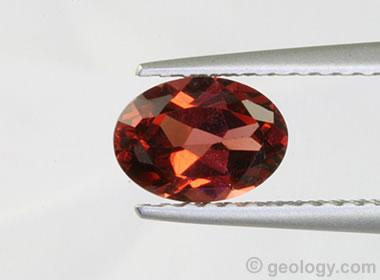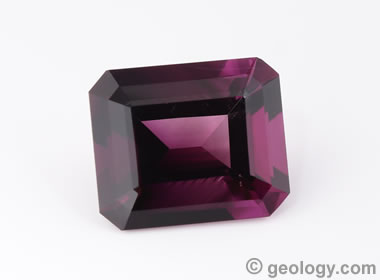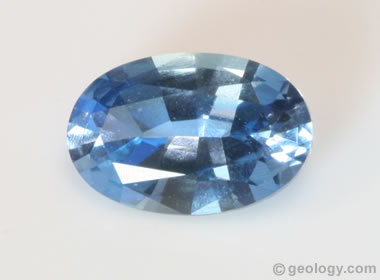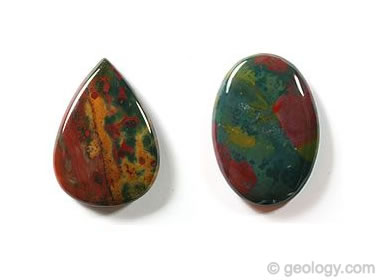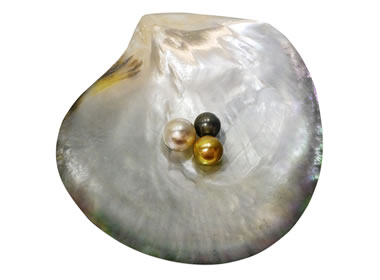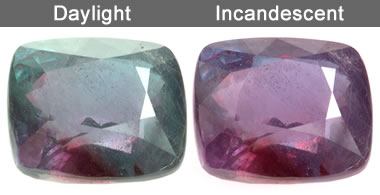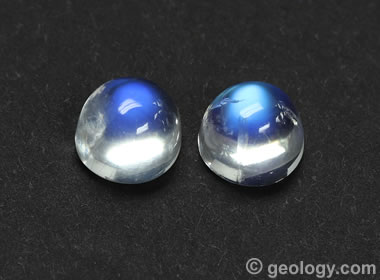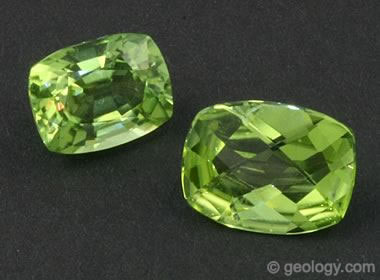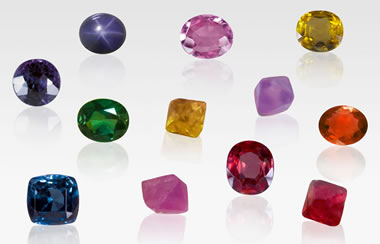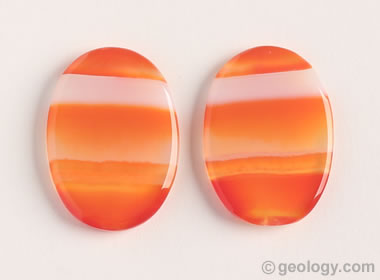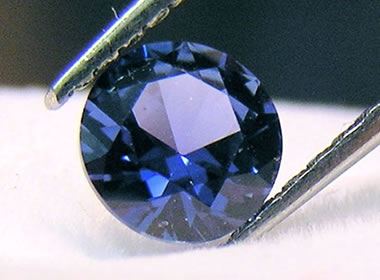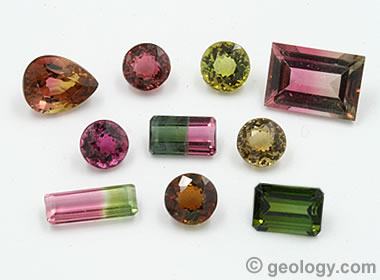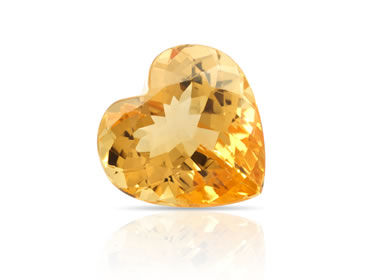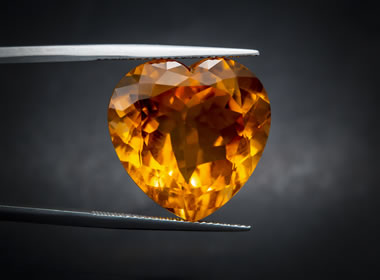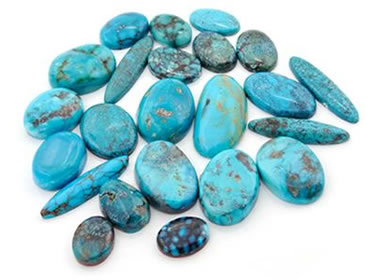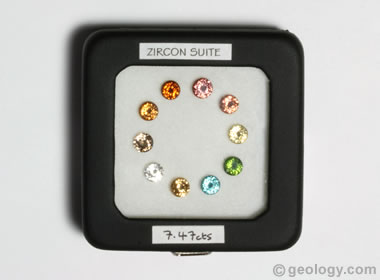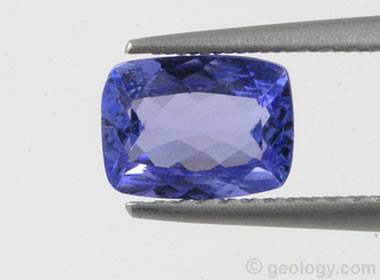Home » Gemstones » Birthstones
Birthstones
Gemstones for the Month of a Person's Birth
Author: Hobart M. King, PhD, GIA Graduate Gemologist
Click a stone for more information!

Birthstones by Month: January: Garnet. February: Amethyst. March: Aquamarine, Bloodstone. April: Diamond. May: Emerald. June: Pearl, Alexandrite, Moonstone. July: Ruby. August: Peridot, Spinel, Sardonyx. September: Sapphire. October: Opal, Tourmaline. November: Topaz, Citrine. December: Turquoise, Zircon, Tanzanite.
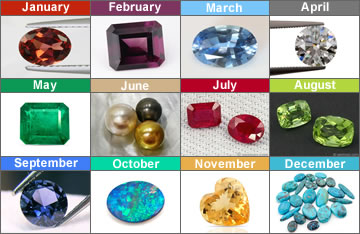
Birthstones are gemstones that represent the month of a person's birth. As an example, emerald is the birthstone for the month of May. So, people born in May have emerald as their birthstone. Click on a month to see the birthstone(s) for that month.
Table of Contents
1. January Birthstone: Garnet |
Garnet
Garnet is the birthstone of January. Although many people think of a red gem when they think of garnet, it is actually available in almost every color - green (tsavorite and demantoid), orange (spessartine and hessionite), purple (rhodolite), yellow (mali and topazolite), pink (malaya), red (almandine and pyrope), black (melanite). These are just some of garnet's many colors and varieties. There are even opaque garnets that are usually cut as a cabochon (pink hydrogrossular and green grossularite). The color variety of garnet gives people born in January many color options.
The accompanying photo shows some of the many different colors in which garnet can occur. Top row, from left to right: orange spessartite (Mozambique), yellow mali (Mali), green demantoid (Namibia). Middle row: green tsavorite (Tanzania), purple rhodolite (Mozambique), pink malaya (Tanzania). Bottom row: red pyrope (Cote d'Ivoire), green merelani mint (Tanzania), orange hessonite (Sri Lanka). Except for the orange hessonite from Sri Lanka, all of these garnets were mined in Africa, the relatively new source of spectacular garnets.
2. February Birthstone: Amethyst |
Amethyst
Amethyst is the birthstone for February. It is the world's most popular purple gem - and that enhances its status as a birthstone. The purple color of amethyst can be so light that it is barely perceptible, or so dark that a faceted gem can be nearly opaque. The color of amethyst spans a range from violetish purple, to purple, to reddish purple. The gem shown here is a beautiful reddish purple amethyst from the Four Peaks Mine in Maricopa County, Arizona. Four Peaks is the most important amethyst mine in the United States.
3. March Birthstones: Aquamarine and Bloodstone |
Aquamarine
Aquamarine is the the birthstone for the month of March. Aquamarine is the blue variety of the mineral known as beryl. It occurs in a range of colors from slightly greenish blue to a nearly pure blue hue.
Aquamarine also occurs in a range of color saturations, from a very light, almost imperceptible blue to a rich deep blue. The richly colored aquamarines with the purest blue color are most popular. Many people enjoy the light-colored stones which are much more affordable.
Bloodstone
Bloodstone is another gem that serves as a birthstone for March. It is an opaque green chalcedony that is marked with splashes of red and often other colors. Bloodstone receives its name from the red splashes of blood-like color. As an opaque gem, bloodstone is usually cut into dome or shield-shaped gems known as cabochons. It has been a popular gemstone for at least two thousand years. In Europe and in older publications bloodstone is known by the name "heliotrope". Bloodstone is a popular and durable gem for men's rings, cufflinks, and tie tacks.
4. April Birthstone: Diamond |
Diamond
Diamond is the birthstone of April. It is the world's most popular gem. Many people enjoy diamond because of its brilliance and because of its dispersion. Dispersion is the ability of a gem to act as a prism and separate light into its component colors - as shown by the diamond in the accompanying photo.
Diamond is one of the most expensive birthstones. When cost is a concern, many people opt for a smaller stone. Others decide to purchase a more affordable lab-grown diamond. If cost is not an issue, then a beautiful colored diamond might be possible! Image copyright iStockphoto / Greg Stanfield.
5. May Birthstone: Emerald |
Emerald
Emerald is the birthstone for the month of May. It is the world's most popular green gem. It is the green variety of the mineral beryl. Emeralds range in color from slightly yellowish green, to pure green, to slightly bluish green. Pure green emeralds are the most popular and valuable.
Emerald can be a costly gem, and it often lacks the high level of clarity that many people desire. For that reason, lab-grown emeralds have become a popular option in birthstone jewelry. Lab-grown emeralds can be purchased at a small fraction of the cost of a natural emerald of similar size, color, and clarity. The buyer and the recipient of an emerald birthstone gift might be pleased with this option. Image copyright iStockphoto / mikheewnik.
6. June Birthstones: Pearl, Alexandrite, and Moonstone |
Pearl
Pearl is an organic gem and the traditional birthstone for the month of June. There are three basic types of pearls: 1) natural pearls, which form naturally within the shell of a living mollusk; 2) cultured pearls, which are propagated by people by inserting a "seed" into a mollusk shell with the intent that the mollusk will deposit layers of nacre around it; and, 3) imitation pearls, which are usually plastic beads with a lustrous coating applied. Most pearls in today's market are cultured pearls, which are very affordable when compared to natural pearls, and make a much nicer gift than imitation pearls. Most jewelry stores sell pearl jewelry, most often with cultured pearls. The pearls in the photo are a white South Sea pearl, a black Tahitian pearl, and a gold South Sea pearl. Image copyright iStockphoto / barbaraaaa.
Alexandrite
Alexandrite is a color-change variety of chrysoberyl that appears as different colors under daylight and incandescent illumination. Pictured here is a faceted specimen of color-change alexandrite of 26.75 carats from Tanzania, showing a blue-green color in daylight and a purple-red color under incandescent light. Natural alexandrite of good color and clarity is an extremely expensive gem, however, lab-created alexandrite can be found in many jewelry stores. Some of the lab-grown alexandrite has a spectacular appearance! Photo by David Weinberg for Alexandrite.net and published here under a GNU Free Document License.
Moonstone
Moonstone is a feldspar mineral that produces a "pearly" luster when light enters the stone and is reflected by mineral layers within the gem. Moonstone is most often a white or gray color with a glow that is white or silvery - like the glow of the moon (that's how it got its name!). Moonstone also occurs in pink, orange, near-colorless and other colors. Rare moonstones produce a blue or a multicolored glow. These are called "rainbow moonstones" and they are market favorites. The accompanying photo shows two cabochons of rainbow moonstone with a bright blue glow.
7. July Birthstone: Ruby |
Ruby
Ruby is the birthstone for the month of July and the world's most popular red gem. Rubies range in color from orangy-red, to red, to slightly purplish-red. The most desirable and valuable colors are pure red and slightly purplish red. Natural rubies have historically been expensive gems, but recent discoveries in Africa bring many attractive natural rubies into the market at affordable prices.
Lab-grown ruby is very common in jewelry stores in the United States. Lab-grown rubies have been in the United States jewelry market since the early 1900s. Today, if you go to a mall jewelry store such as Zales or Kay Jewelers, you will encounter a case with a large assortment of ruby jewelry items for sale. Many of them will likely be synthetic or lab-grown ruby. If you spend time studying them, you might note that the synthetic gems usually have better clarity and better color than natural gems of similar price. Many people are happy to pay the higher price for natural gems because they treasure gems that formed naturally within the Earth. Others are happy with the great appearance and lower price of lab-created gems.
8. August Birthstones: Peridot, Spinel, and Sardonyx |
Peridot
Peridot is a traditional birthstone for the month of August. It has a yellowish green color and is one of the world's most popular and affordable green gems. Shoppers can expect to find it in almost every jewelry store.
Peridot is the gem variety of a mineral group known as olivine. Much of the world's peridot is found in basalt flows. Basalt is an igneous rock that solidified from lavas erupted from volcanoes. The green sand beaches of Hawaii contain peridot crystals weathered from basalt. Some peridot falls to Earth in meteorites.
Spinel
Spinel is a newcomer to birthstone jewelry. In July 2016, the American Gem Trade Association and the Jewelers of America named spinel a birthstone for the month of August. Being named a birthstone will do more for the popularity of spinel than millions of dollars spent on advertising.
Spinel is the perfect birthstone. First, spinel occurs in every color of the spectrum - now people born in August are no longer limited to a yellowish-green peridot. Spinel occurs in a red color similar to ruby and a blue color similar to sapphire. Red and blue are both common natural colors for spinel.
Second, spinel is an extremely durable gem. It has the hardness and toughness for use in any type of jewelry - and that durability will enable it to endure over a lifetime of wear. Very few gems are more durable than spinel.
Sardonyx
Some (but not all) birthstone lists include sardonyx as a birthstone for August. Sardonyx is a banded variety of chalcedony that exhibits straight, parallel bands of white, black, orange, red, or brown chalcedony. Some of the most spectacular cabochons and beads are cut from sardonyx.
Sardonyx has also been used as a material for cutting cameos. These take advantage of the layered, multicolored nature of the material. Cameos have been popular in jewelry for at least 2000 years. (Cameos are often cut from many other materials, especially shell materials, but many of the finest cameos are cut from sardonyx.)
9. September Birthstone: Sapphire |
Sapphire
Sapphire is the birthstone for September. Most people immediately think of a blue gem when they hear the name "sapphire". That is because gem-quality specimens of the mineral corundum with a blue color are called "sapphire" by definition. However, corundum occurs in many colors. When it is pink, orange, green, purple, yellow, or any of these other colors, the name "fancy sapphire" is used.
Some of the world's finest sapphires have been mined in a Montana locality known as Yogo Gulch. If you know someone with a September birthday who lives in Montana, a Yogo sapphire might be the perfect birthstone gift. Creative Commons photo of a gem from Barnes Jewelry, Helena, Montana, by Montanabw.
10. October Birthstones: Opal and Tourmaline |
Opal
Opal is an original modern birthstone for the month of October. Some people call it the world's most colorful gem because one stone can display a full spectrum of colors. Opal occurs many different varieties. The accompanying image is a black opal from Australia, but there are also fire opals from Mexico, honeycomb opals from Ethiopia, and colorful common opals from Peru. Lab-grown opals are available in a wide variety of colors and appearances for people who would like to obtain an attractive item for a lower price. Lab-grown opals are being sold today in many jewelry stores. Image copyright iStockphoto / mikheewnik.
Tourmaline
Tourmaline occurs in a wide variety of colors. The accompanying photo shows a collection of faceted tourmalines of various colors. Some of these stones exhibit multiple colors because they were cut from color-zoned crystals. Two are pink and green bicolor stones known as "watermelon tourmaline." Bicolor and pleochroic tourmalines are favorite stones of many jewelry designers because they can be used to make especially interesting pieces of jewelry.
Tourmaline is not an original birthstone for October. It was added to most birthstone lists in 1952. Some lists specify "pink tourmaline" for people born in October. Tourmaline gives people born in October the option of a colorful faceted stone and a stone more durable than opal.
11. November Birthstones: Topaz and Citrine |
Topaz
Topaz is a birthstone for the month of November. It occurs in a wide range of natural and treated colors that include blue, pink, purple, yellow, brown, orange, and colorless. Topaz is a very durable stone with a Mohs hardness of 8. Diamond, ruby and sapphire are the only commonly used gemstones with a greater hardness.
The most popular color of topaz sold in jewelry today is blue. Natural blue topaz exists but it is very rare and very expensive. Fortunately for people born in November who like blue, colorless topaz can be treated with irradiation and heat to produce a variety of blue colors. Swiss blue and London blue are two of the most popular blue colors in treated topaz. Topaz is also coated to produce a range of iridescent colors and stones that appear to change color depending upon the angle at which they are viewed. These coated stones are called "mystic topaz". Image copyright iStockphoto / mikheewnik.
Citrine
Citrine is the world's best-selling gem with a yellow to orange color. It is a favorite gem because of its affordability and durability. It is durable because of its Mohs hardness of 7 and affordable because of its abundance.
Citrine is not as easy to find in jewelry stores as blue topaz, but with a little searching you should be able to find it. Citrine is not an original modern birthstone for November. It was added to most birthstone lists in 1952. At that time topaz was a relatively costly gem, but the discovery of large deposits in Brazil have greatly reduced the price of topaz. Most citrine also comes from Brazil. Image copyright iStockphoto / wirachai moontha.
12. December Birthstones: Turquoise, Zircon, and Tanzanite |
Turquoise
Turquoise is a birthstone for the month of December. It is a blue to blue green to yellowish green mineral that has been used as a gemstone for thousands of years. Bright blue turquoise is the most preferred color. It is most often set into sterling silver jewelry. Because it is opaque, it is usually cut into cabochon shapes, often freeform to take full advantage of the rough, instead of being cut into calibrated shapes and sizes.
In the southwestern United States, Native Americans were using turquoise over 2000 years ago. There, ancient artists produced beads, pendants, inlay work, and small sculptures. Turquoise is still an important part of Southwestern culture.
Turquoise jewelry is not extremely expensive. Many people can afford to purchase genuine turquoise, but lab-created turquoise is available in some stores for cost-conscious shoppers. Image copyright iStockphoto / IrisGD.
Zircon
Zircon is another gem that serves as a birthstone for the month of December. It is a bright gem with high luster, and many specimens produce a colorful fire that is similar to diamond. Because of these properties, zircon was once used as an alternative stone for diamond.
Zircon gives the shopper an opportunity to select from a variety of colors. Blue is the most popular zircon color. Most natural zircons are yellow, red or brown, but heat and irradiation treatments can transform them into blue, green and many other colors. About 80% of the zircons sold today are blue, with the color produced by treatment. Zircon replaced lapis lazuli as a modern birthstone in 1952.
Tanzanite
Tanzanite is the newest birthstone for the month of December. Most tanzanite sold in jewelry today has a blue to bluish purple to bluish violet color that is produced by heat treatment. Its color has an interesting feature - it changes depending upon the angle of viewing. If you have tanzanite jewelry, look at the stone face up and then from the side - you might be able to notice a slight color difference.
Tanzanite was added as a modern birthstone in 2002. "Tanzanite" is a trade name that was first used by Tiffany and Company for gem-quality specimens of the mineral zoisite with a blue color. The gem was first discovered in the 1960s in the country of Tanzania, and that is the origin of the gem's name. Shown here is a violet-blue tanzanite measuring 7 x 5 x 3 millimeters in size and weighing 1.02 carats, antique facet cut. This grade of tanzanite is often seen in mall and chain store jewelry.
More Information About Birthstones |
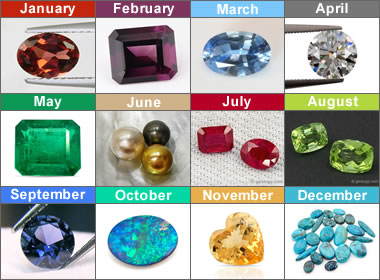
Birthstone Gems: Shown here are examples of birthstones for each month. January: Garnet. February: Amethyst. March: Aquamarine. April: Diamond. May: Emerald. June: Pearl. July: Ruby. August: Peridot. September: Sapphire. October: Opal. November: Topaz. December: Turquoise.
What Are Birthstones?
Birthstones are gemstones that represent the month of a person's birth. As an example, emerald is the birthstone for the month of May. So, people born in May have emerald as their birthstone.
The use of specific gems as "birthstones for a specific month" and wearing them in jewelry is a custom that began in eighteenth-century Europe and quickly spread to the United States. [1] The practice became popular in the United States, and in 1912, the American National Retail Jeweler’s Association (now named Jewelers of America) adopted a standardized list of monthly birthstones which went into use by jewelers throughout the country. [2] Birthstone jewelry is still very popular in the United States.
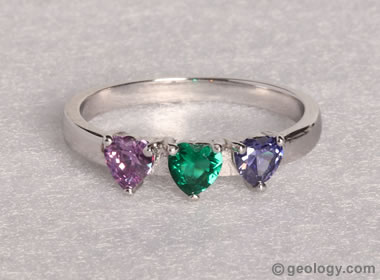
Mother's Birthstone Ring: A Mother's Ring displaying a lab-grown birthstone for each of her children.
Birthstone Jewelry Popularity
Wearing and gifting birthstone jewelry is a long-standing custom in many countries. In the United States alone, consumers buy millions of dollars' worth of birthstone jewelry every month.
The first jewelry item that many children receive is often a birthstone ring, earrings, or pendant. Three-piece sets that include a birthstone ring, pendant, and pair of earrings are sold in many stores. These sets are popular birthday and graduation gifts. Some students select their birthstone as the center stone of their high school or college class ring.
Mothers often wear rings, pendants, or pins that contain their children's birthstone(s). A “Mother’s Ring” is a woman’s ring that is set with the birthstones of her children. Mother’s rings are sometimes purchased by a mother but they are often a gift to the mother from her husband or from her children. They are often engraved with the names of the children or with a special message.
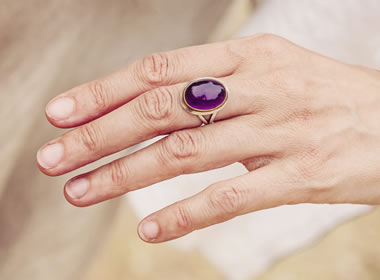
Amethyst Ring: Birthstone jewelry is very popular in the United States and other countries. Shown above is a gold ring with a large amethyst cabochon. Image copyright iStockphoto / MadKruben.
Birthstones facilitate the purchase and sale of many jewelry items. Birthstones serve as both a purchasing and marketing aid. Here is how that might happen...
A shopper is looking for a gift for a niece and is having difficulty finding "the perfect item". The salesperson asks the birthdate of the niece. Upon learning that the niece was born in February, the salesperson shows the shopper to a nice display of amethyst jewelry.
The shopper quickly finds an amethyst jewelry set consisting of a ring, a pendant necklace, and a pair of earrings. The "birthstone idea" helped the salesperson make a sale and helped the shopper select a personalized gift. The niece will likely be happy with her birthstone gift.
Many shoppers, gift recipients, and jewelers enjoy the idea of birthstones jewelry. But, the concept of birthstone marketing has its critics. Some people believe that birthstones are nothing more than an arbitrary assignment of gemstones to months, used as a marketing ploy to sell jewelry. [3] It is likely that a larger number of people have given a birthstone jewelry gift and enjoyed seeing a delighted recipient.
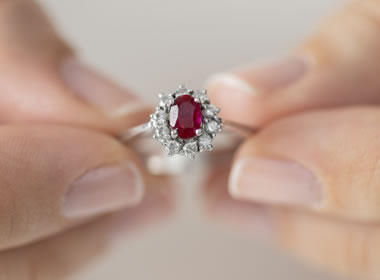
Birthstone Engagement Ring: The ring above is an excellent example of a birthstone engagement ring. It has a center stone of natural ruby (the July birthstone), surrounded by white diamonds, and mounted in white gold. Ruby is an excellent choice for an engagement ring. It has a Mohs hardness of 9, just one step below diamond. This high hardness makes ruby just one of a few colored gemstones that are durable enough for daily wear across a lifetime. Image copyright iStockphoto / solidcolours.
Birthstone Engagement Rings
A growing trend in bridal jewelry is the "birthstone engagement ring". Many couples are looking for color, or are looking for a stone other than diamond. The birthstone engagement ring can be a logical, affordable, and attractive choice for these couples.
If you were born in April, this idea might not work because diamond is the birthstone for the month of April. In that case consider a colored diamond. Natural yellow, black, and brown diamonds are very affordable. If you can't afford a natural diamond in other colors, lab-grown diamonds can be purchased in almost any color at a savings below the cost of a white diamond of similar color and clarity.
The birthstone can be the main stone of the ring, or multiple birthstones can be mounted beside or around the diamond. You can personalize your engagement ring to the month of your birth and in your own unique style.
Ruby (July), sapphire (September), aquamarine (March), alexandrite (June), and spinel (August), are durable enough to serve as an engagement ring gem. They have a Mohs hardness of 7.5 or higher, which means that they will rarely come in contact with an object that will abrade them. Placed in a mounting that provides proper protection, these birthstones should be able to withstand decades of wear. [4]
| Birthstone Information |
|
[1] The Curious Lore of Precious Stones: Being a Description of their Sentiments and Folk Lore, Superstitions, Symbology, Mysticism, Use in Medicine, Protection, Prevention, Religion, and Divination, Crystal Gazing, Birth Stones, Lucky Stones and Talismans, Astral, Zodiacal and Planetary; by George Frederick Kunz, published by J.B. Lippincott Company, 406 pages, 1913.
[2] Birthstone Jewelry: an article on the Jewelers of America website, last accessed October 2022. [3] Gems in Myth, Legend and Lore; Revised Edition: by Bruce G. Knuth, published by Jewelers Press, 399 pages, 2007. [4] The Hard Truth About Birthstone Engagement Rings: by Rachael Taylor, an article on The Jewellery Editor website, published September 16, 2016, last accessed October 2022. [5] Birthstones for Each Month: an article on the Gemological Institute of America website, last accessed October 2022. [6] Guides for the Jewelry, Precious Metals, and Pewter Industries: Adoption of Revised Guides, published by the Federal Trade Commission in the Federal Register, August 16, 2018. |
Historical Roots of Birthstones
The practice of associating certain gemstones with certain months of the year dates back at least 2000 years. George Frederick Kunz, a mineralogist and gemologist who served as the Vice President of Tiffany & Company in the late 1800s, wrote in his book, The Curious Lore of Precious Stones:
"The origin of the belief that to each month of the year a special stone was dedicated, and that the stone of the month was endowed with a peculiar virtue for those born in that month and was their natal stone, may be traced back to the writings of Josephus, in the first century of our era, and to those of St. Jerome, in the early part of the fifth century. Both these authors distinctly proclaim the connection between the twelve stones of the high-priest’s breastplate and the twelve months of the year, as well as the twelve zodiacal signs." [1]
"However, in spite of this early testimony, we have no instance of the usage of wearing such stones as natal stones until a comparatively late date; indeed, it appears that this custom originated in Poland some time during the eighteenth century." [1]
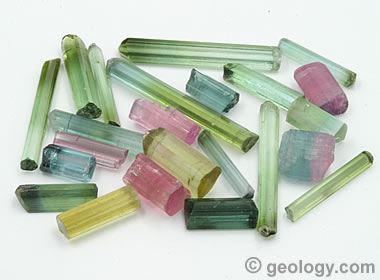
Colorful tourmaline crystals: Tourmaline was added as a birthstone for October in 1952. Tourmaline occurs in many colors, which gives people born in October many color choices for their birthstone.
How Today's Birthstone List Evolved
Standardization of the birthstone list in 1912 was a good thing to do. It reduced confusion between organizations and individuals who had different ideas of which birthstones should be used to represent different months. However, the list has been modified several times since 1912 - and there are still multiple "birthstone lists" in use. Fortunately, there are only a few points of departure among the many lists used in the United States and the United Kingdom.
Some modifications of the original list that are in general agreement include: (A) tourmaline was added as an August birthstone to give people color choices beyond yellowish-green peridot, (B) spinel joined opal as an October birthstone for greater durability and the option of a faceted stone, (C) the lapis lazuli of December was replaced by zircon and later tanzanite - after its 1967 discovery. The list shown at the top of this page is one recently published by the Gemological Institute of America. [5]
Mohs Hardness of Birthstones | |||
| Month | Gemstone | Mohs Hardness | Durability |
| January | Garnet | 6.5 to 7.5 | Good |
| February | Amethyst | 7 | Good |
| March | Aquamarine Bloodstone | 7.5 to 8 6.5 to 7 | Very Good Good |
| April | Diamond | 10 | Excellent |
| May | Emerald | 7.5 to 8 | Fair |
| June | Pearl Alexandrite Moonstone | 2.5 to 4.5 8.5 6 to 6.5 | Poor Very Good Poor |
| July | Ruby | 9 | Excellent |
| August | Peridot Spinel Sardonyx | 6.5 to 7 7.5 to 8 7 | Fair Very Good Good |
| September | Sapphire | 9 | Excellent |
| October | Opal Tourmaline | 5.5 to 6 7 to 7.5 | Poor Good |
| November | Topaz Citrine | 8 7 | Poor Good |
| December | Turquoise Zircon Tanzanite | 5 to 6 6 to 7.5 6.5 | Poor Fair Fair |
Birthstone Hardness and Durability
Gems vary in hardness and durability. Below we have rated the birthstones according to their suitability for use in various types of jewelry, giving them ratings from "poor" to "excellent". The ratings below apply only to natural gems. If you are considering a synthetic birthstone, they generally rate between good and excellent, but a consultation with a jeweler can determine if they are suitable for your intended use.
Excellent: The most durable birthstones are diamond (April), ruby (July), and sapphire (September). All of these gems have hardness of 9 or 10, excellent durability, and are suitable for any use in jewelry.
Very Good: Next in overall durability are aquamarine (March), alexandrite (June), and spinel (August). They have a hardness of at least 7.5 and very good durability. These gems are also suited for use in any type of jewelry.
Good: A number of gems are durable enough for use in any type of jewelry. However, because of their hardness they are subject to being scratched or abraded. If they are used in a ring or a bracelet, a mounting that protects them from impact and abrasion is a good idea, as is removing the jewelry during activities that might result in damage. These gems are garnet (January), amethyst (February), bloodstone (March), sardonyx (August), tourmaline (October), and citrine (November).
Fair to Poor: Gems rated less than good have some defecit that makes them vulnerable to breakage or abrasion. Emerald (May), opal (October), peridot (August), and zircon (December) are all prone to breakage. Moonstone (June), topaz (November), and tanzanite (December) all have perfect cleavage and will break easily. Pearl (June), opal (October), and turquoise (December) all have a low hardness and are easily scratched.
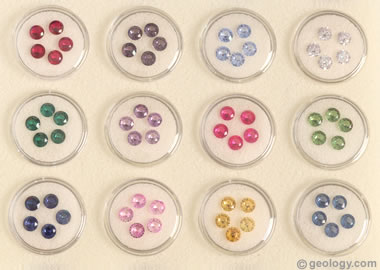
Imitation Birthstones: Synthetic and imitation gems are often used in birthstone jewelery. They have wonderful color and clarity that simulates the appearance of a high-quality natural gem at a much lower cost. The photo above shows examples of the man-made materials that are used.
January: lab-created corundum substituting for garnet.
February: lab-created spinel doublet substituting for amethyst.
March: lab-created spinel substituting for aquamarine.
April: lab-created cubic zirconia substituting for diamond.
May: lab-created spinel doublet substituting for emerald.
June: lab-created corundum substituting for alexandrite.
July: lab-created corundum substituting for ruby.
August: lab-created spinel doublet substituting for peridot.
September: lab-created corundum substituting fo sapphire.
October: lab-created corundum substituting for tourmaline.
November: lab-created corundum substituting for topaz.
December: lab-created spinel substituting for blue zircon.
Lab-Created and Simulant Birthstones
Although many birthstone gems are affordable, some, such as diamond, emerald, and ruby, can be expensive. Decades ago, many jewelry manufacturers began using lab-grown and imitation gems in some commercial birthstone jewelry.
These man-made alternative gems, along with sterling silver or low-carat gold mountings, provided three benefits: they (1) significantly reduced the cost of the item; (2) improved the size, color, and clarity of the stones that the buyer was able to afford; and, (3) allowed a better profit margin for sellers.
Many people are delighted with the lower-cost alternative. However, it is very important for the salesperson, product labeling, and receipt to clearly state that the birthstones are man-made and not natural gems - in language that any customer should easily understand. This disclosure is very important because many people only want to purchase jewelry made with natural gems. Also, selling synthetic gems without clearly disclosing their man-made origin to customers is a violation of the Guides for the Jewelry, Precious Metals and Peweter Industries, published by the Federal Trade Commission. [6]
| More Gemstones |
 |
Tourmaline |
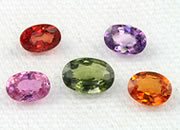 |
Fancy Sapphires |
 |
Diamond |
 |
Canadian Diamond Mines |
 |
Birthstones |
 |
Pictures of Opal |
 |
Fire Agate |
 |
Blue Gemstones |

Find Other Topics on Geology.com:

|

| ||

|

| ||

|

| ||

|

|


